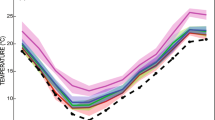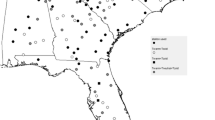Summary
The crop model CERES-Wheat in combination with the stochastic weather generator were used to quantify the effect of uncertainties in selected climate change scenarios on the yields of winter wheat, which is the most important European cereal crop. Seven experimental sites with the high quality experimental data were selected in order to evaluate the crop model and to carry out the climate change impact analysis. The analysis was based on the multi-year crop model simulations run with the daily weather series prepared by the stochastic weather generator. Seven global circulation models (GCMs) were used to derive the climate change scenarios. In addition, seven GCM-based scenarios were averaged in order to derive the average scenario (AVG). The scenarios were constructed for three time periods (2025, 2050 and 2100) and two SRES emission scenarios (A2 and B1). The simulated results showed that: (1) Wheat yields tend to increase (40 out of 42 applied scenarios) in most locations in the range of 7.5–25.3% in all three time periods. In case of the CCSR scenario that predicts the most severe increase of air temperature, the yields would be reduced by 9.6% in 2050 and by 25.8% in 2100 if the A2 emission scenario would become reality. Differences between individual scenarios are large and statistically significant. Particularly for the time periods 2050 and 2100 there are doubts about the trend of the yield shifts. (2) The site effect was caused by the site-specific soil and climatic conditions. Importance of the site influence increases with increasing severity of imposed climatic changes and culminates for the emission scenario A2 and the time period 2100. The sustained tendency benefiting two warmest sites has been found as well as more positive response to the changed climatic conditions of the sites with deeper soil profiles. (3) Temperature variability proved to be an important factor and influenced both mean and standard deviation of the yields. Change of temperature variability by more than 25% leads to statistically significant changes in yield distribution. The effect of temperature variability decreases with increased values of mean temperature. (4) The study proved that the application of the AVG scenarios – despite possible objections of physical inconsistency – might be justifiable and convenient in some cases. It might bring results comparable to those derived from averaging outputs based on number of scenarios and provide more robust estimate than the application of only one selected GCM scenario.
Similar content being viewed by others
Author information
Authors and Affiliations
Rights and permissions
About this article
Cite this article
Trnka, M., Dubrovský, M., Semerádová, D. et al. Projections of uncertainties in climate change scenarios into expected winter wheat yields. Theor Appl Climatol 77, 229–249 (2004). https://doi.org/10.1007/s00704-004-0035-x
Received:
Revised:
Accepted:
Published:
Issue Date:
DOI: https://doi.org/10.1007/s00704-004-0035-x




